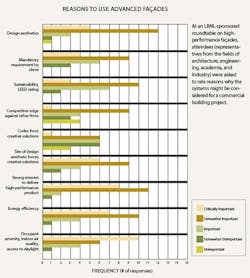High-Performance Façades: It’s What’s Outside that Counts (4 of 4)
The Decision-Making Process
High-performance façades are complex systems that require understanding and consideration of everything from thermodynamics and material sciences to air flow, lighting and daylighting, and HVAC. Each of these should be considered; consideration of one at the expense of another can result in one-sided performance or a faulty system.
When considering an advanced façade, simultaneous discussion between all involved parties is the most effective way to make choices. Computer-based tools can also aid in the decision-making process. While no tool designed exclusively for simulation and analysis of integrated façade systems is available yet, some general computer-based building tools can serve the purpose when used by professionals who understand the tools’ capabilities and limitations. For example, whole building energy tools can simulate the energy performance of a building over periods of time to emulate the effects of a particular high-performance façade system on energy consumption.
Other points to consider:
- First cost is usually given the most consideration in decision-making for integrated façade systems. But, high-performance façade systems don’t have to cost more. If a certain level of performance is an objective, an advanced façade which achieves that performance may actually cost less than an elaborate building skin that may (or may not) provide comparable performance.
- Operating and maintenance costs are other important considerations. If planned, designed, and installed properly integrated façade systems usually result in lower overall operating costs.
- Technical merit and constructability of integrated façade systems should also be considered. The proposed system may include components that haven’t been proven to work together under a particular condition, or may be difficult to construct in a given location. (This is predominantly true considering new technologies.)
- Future users and operators of the building are rarely aware of the assumptions made in façade design; they may try to operate the building (including the façade) without understanding its constraints. Take into consideration the fact that proper function depends on proper use and operation, timely maintenance, and a thorough understanding of possible problems and malfunctions.
Leah B. Garris ([email protected]) is senior associate editor at Buildings magazine.
Much of this information was provided by Lawrence Berkeley National Laboratory’s High-Performance Commercial Building Façades review.

